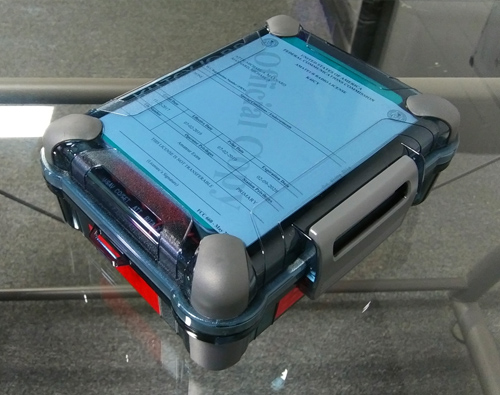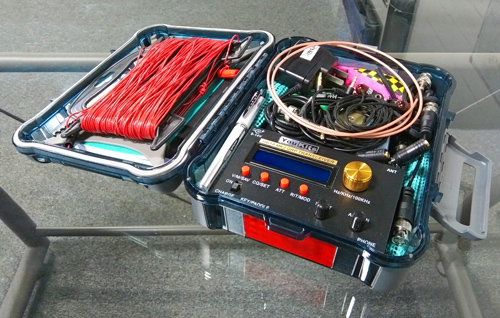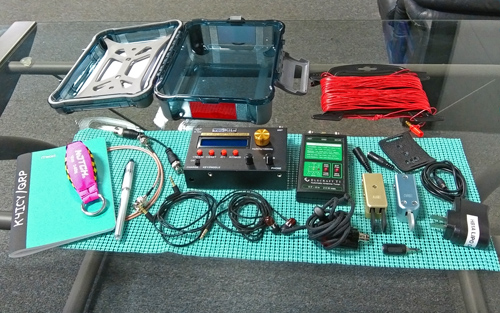Moto-QRP K4ICY's Portable Weatherproof HB1A QRP Setup is suitable for Backpacks and Motorcycle Panniers There are and increasing number of commercially-built Amateur Radio transceivers these days which are small, feature-packed and run in the 1 to 10 watt range. Mostly intended on the worldwide market as Foundation Class (Like Novice) starter radios, their low power levels and size are perfect for the QRP aspect of the hobby. "QRP" if you don't know, is the old Morse code procedural sign for 'Send Less Power' and is generally accepted these days at the intent to operate at no more than 5 watts.  5 Watts is really nothing to sneeze at as a CW signal of this humble level can often be found bouncing around for thousands of miles on a night with great RF propagation. In fact, many hams pride themselves on using 1 watt or less (or QRPp) and even obtain awards for getting 1,000 miles per watt! I found my YouKits HB1A MKII at a swap table down at the Orlando Hamcation a few years ago for not much money. It's not the HB1B model so commonly found these days as this one only has access to transmitting on 40 and 20 meters, but those are great bands to have. My HB1A isn't exactly "5" watts across the bands and actually has an input of 3.5 watts on 40 meters and up to 10 watts on 20 meters. By the time the signal is most likely attenuated by losses in the 'compromise' antenna I'm using, both are likely to be a lot less. It's internal lithium-ion battery packs a good bit of play time within and keeps it relatively light. My antenna system is somewhat of a long-wire setup, or even an OCF as the radiator element, at 64', which is draped over any available nearby tree branch with help of a throw weight. The counterpoise element is at 35' and is layed out on the ground running in the opposite direction. I used a 24 gauge red insulator stranded copper wire for compactness and visibility. The antenna inputs are connected via 'banana' plugs at a physical anchor point which can be tied to a picnic table and can detatch, say, if some unaware park goer runs through it. An Elecraft T1 tuner, [Shown Here], which was built from a kit, is used to match the antenna to the HB1A.  My keys include the very (virtually) indestructable and compact, all-metal Ultra Porta Paddle, dual-lever paddle and Mini-B Miniature Single Lever/Sideswiper Paddle from American Morse Equipment so I'm able to do Iambic keying in both single and dual lever action as well as in sideswiper or "cootie" modes whis is great for SKCC contacts. A common stereo to mono adapter works well to allow the HB1A to 'see' the connected key as a straight key or to use the key as a quick way to tune the rig simply by turning the rig off and on with the adapter installed. I'm using the metal base of AME's Leg Mount to tie down the key, missing in the photo is a thick black rubber band which holds the paddle in place and keeps the base from sliding around. These items and other are all nested within the plastic weatherproof case (found at Walmart) and the whole thing weighs just at 5 lbs (2.25 kg) and is small enough to fit inside of a backpack or within the saddle bag or side pannier of a motorcycle - this is the operating intent of this station. My plan is to visit many parks, lighthouses and other regional locations on my Triumph Bonneville T120 Black and enjoy a few CW contacts.  (Click for large image with descriptions) (Click for large image with descriptions)Other items include: A copy of my FCC grant which may come in handy if an officer or security guard isn't so savvy on what this ham radio operator is doing setting up strange devices at a public site. A small notebook for sketching down details and CW copy as well as logging contacts. An ink pen which is heat and pressure resistant. Theses are labeled as "safe for airline flights." I have a nice little set of high quality ear buds but there might be space for a small amplified speaker. Paddingle the bottom is a section of foam drawer liner that I use to help keep things 'gripped' to any picnic table and the dirt off the equipment. I'll post more here as I improve this setup.
|